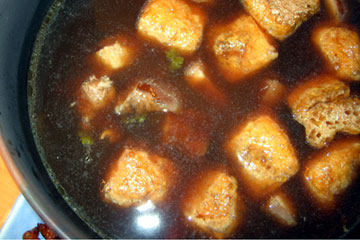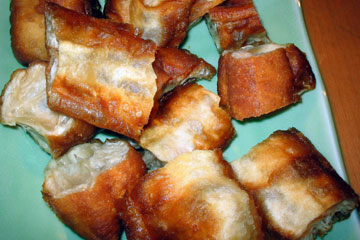New York, New York - Bah kut teh (translated literally means pork rib tea) is one of Malaysia and Singapore's great culinary gifts to the world. Pork rib tea is usually cooked or served in a clay pot and contains various pork meats including spare ribs and intestines as well as garnishings of mushroom, lettuce and tofu. The broth is made with soy sauce, several herbs and spices like star anise, cinnamon, garlic cloves, white and black peppercorn. Pork rib tea is commonly eaten with rice and is most enjoyable when consumed with fried dough sticks also known as deep-fried crullers or yau char kwai. In Malaysia it is almost unthinkable for the dish not to be eaten with crullers.

The dish is so popular in Malaysia and Singapore that it is served for breakfast, lunch and dinner and has even spawned a version with chicken called chi kut teh. Pork rib tea is also served with a condiment of chopped "chili padi" or very spicy small green chilies which are topped with soy sauce. One can dip the meat from the dish in this condiment to give added flavor. Chinese tea is also served with pork rib tea as it helps dilute or dissolve the fat in the dish.
One reason for the popularity of pork rib tea stems from its perceived health benefits. According to popular belief, the dish is reported to have been invented in the town of Port Klang in Malaysia by migrant Chinese workers in the early 20th century to supplement their meager diet and act as a tonic to boost their health. There is also a belief that the herbs and peppers make one sweat which in turn helps rid the body of toxins. Rumor has it that pork rib tea is useful in curing stomach flu and contributing towards the prevention of rheumatism.
Bah kut teh/pork rib tea can found at the following Malaysian and Singaporean restaurants:
Jaya Malaysian Restaurant, 90 Baxter Street (at Walker Street), Tel: 212-219-3331
New Malaysia Restaurant, 46-48 Bowery (between Canal & Bayard Streets), Tel: 212-964-0284
Nyonya, 194 Grand Street (between Mulberry & Mott Streets), Tel: 212-334-3669
Penang Restaurant, 41 Elizabeth Street (between Canal & Hester Streets), Tel: 212-431-8722
Sanur Restaurant, 18 Doyers Street, 212-267-0088
Singapore Café, 69 Mott Street (at Canal Street), Tel: 212-964-0003
Skyway Restaurant, 11 Allen Street, Tel: 212-625-1153
Unfortunately, most of these restaurants do not serve the most enjoyable complement to this dish, namely the deep-fried crullers. The reason why these restaurants do not serve these crullers is because it is too costly to keep fresh crullers on hand just to be served with this dish. So to properly enjoy pork rib tea, purchase some crullers for take-out and bring it with you to the aforementioned restaurants. Most restaurants will also slice the crullers into smaller sizes for you to dip in the pork rib tea.

Be forewarned: These crullers sell out quickly in Chinatown! They are made fresh daily and used as a staple side-dish with the popular Chinese breakfast of congee (rice porridge). Get up early and head on over to these restaurants to purchase these in-demand crullers to complete your bah kut teh experience:
Big Wong, 67 Mott Street (between Center and Walker Streets), Tel: 212-964-0540
Big Wing Wong Restaurant, 102 Mott Street (between Canal and Hester Streets), Tel: 212-274-0696
C & F Restaurant, 171 Hester Street (at Mott Street), Tel: 212-343-2623
Congee, 98 Bowery, (between Grand and Hester Streets), Tel: 212-965-5028
Congee Village, 100 Allen Street (at Delancey Street), Tel: 212-941-1818
Fu Wong Restaurant, 100 Bowery, Tel: 212-966-2255
Great New York Noodle Town, 28 ½ Bowery, Tel: 212-349-0923
Hsin Wong Restaurant, 72 Bayard Street (at Mott Street), 212-925-6526
New Wing Wong Restaurant, 111 Lafayette Street, Tel: 212-274-0690
About Chinatown New York City
Chinatown New York City combines Asian-American culture with the energy and influence of the most exciting city in the world. With over 200 restaurants, numerous Asian bakeries and tea houses, jewelry shops, arts and antique stores, an active nightlife and dozens of cultural attractions and landmarks, Chinatown stands as a world within a city. Located on the east side of Lower Manhattan, Chinatown New York City is the largest in the United States. The neighborhood has been growing steadily since the mid-1800s, and today stands as a vibrant community offering the opportunity to enjoy and explore Asian-American culture. Chinatown New York City is easily accessible via many New York City MTA subways and buses, as well as several convenient area parking garages. For more information, visit www.ExploreChinatown.com.




